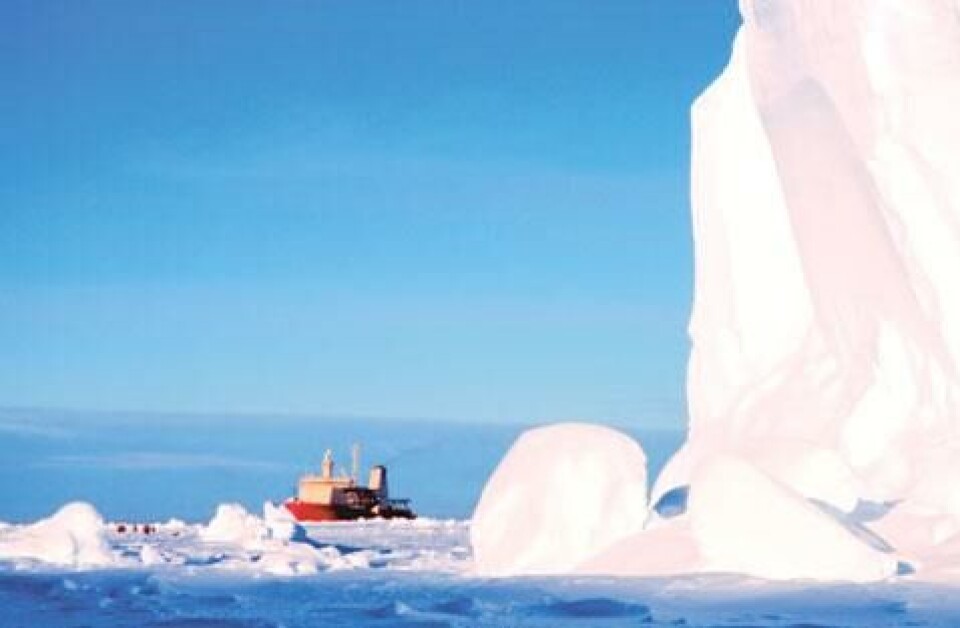
«Aurora Borealis» – en realitet?
Vi siterer en artikkel fra USA datert 2. desember om det planlagte forskningsskipet «Aurora Borealis». Vi gjentar også noe av innholdet fra SKIPSREVYEN nr. 1/2007 – artikkelen “Isgående forskningsskip – alene eller sammen med EU”.
Denne artikkelen er tre år eller eldre.
European researchers are developing an unusual international ship with the ability to break the ice as it moves forward and astern and to port and starboard.
The project was unveiled at the ESF Science Policy Conference recently. Aurora Borealis will be able to drill a hole 1,000 metres deep into the seabed while floating above 5,000 metres of ocean, and to generate 55 megawatts of power.
It is the brainchild of the European Science Federation, the Alfred Wegener Institute for Polar and Maritime Research in Germany and the Germany Federal Ministry of Research and Education.
Russia has announced that it will be a partner in launching this state-of-the-art research vessel. Other European nations are expected to join the project soon. The project, however, requires the solution to a legal issue.
– We do not have a European flag at the moment so one nation has to be responsible. And if it is internationally owned, you can imagine the difficulty, said Nicole Biebow, manager of the project, and a scientist at the Alfred Wegener Institute. – We have to agree where this ship should have its home port. And what happens if there is an accident? Who is responsible if you have an oil spill on the ice, for instance? Biebow added.
The ice over the polar seas masks millions of years of the planet’s history, and drilling is difficult in freezing conditions. Aurora Borealis will be the world’s first icebreaker that is also a drilling ship. – We had some early ice tanks tests and they came up with a design that is able to break ice sideways, said Paul Egerton, head of the European Polar Board within the European Science Federation.
– As the ice continually presses against the side of the ship, the pieces of ice go underneath the hull and are washed away by the propulsion system. There is also a kind of damping system so the ship can raise itself up and down vertically to break the ice. It has a propeller that can turn 360 degrees, linked to satellite navigation. A lot of the cruise ships now have this so they can navigate in a very small area. But the propeller also has to break ice: it has to be strengthened, he added.
The diesel-electric ship will not only be the floating equivalent of a 55 megawatt power station, but it will also be an intellectual powerhouse. It will probe the role of polar waters in global climate change.
While drill cores from the sea floor will be used to answer questions about the geological history of the Arctic ocean, other instruments will measure the transport of contaminants through the air, water and ice.
The vessel could be home to 120 people. It will be equipped with two "moon pools" in the bottom of the hull to give direct access to the open water beneath the ice, so that drillers can work in freezing conditions and biologists can launch underwater vehicles to study the mysterious processes that trigger an explosion of life in the polar seas every spring.
The design and preparation of Aurora Borealis will continue until 2011. The builders may start assembling the hull in 2012. The vessel may be cruising the oceans from 2014, and will probably continue answering some of the great questions of ocean science for the next 40 years. (ANI)
Fra SR 1/2007:
“
Men Norge kan også være med på et kostbart EU-prosjekt. På forsommeren i fjor ble det gitt grønt lys for “European Polar Research vessel «Aurora Borealis»” – annonsert av “The German Science Council Wissenschaftsrat (WR)”. WR ba om Euro 6 millioner straks fra den tyske regjeringen for å løse viktige tekniske spørsmål. Totalprisen for fartøyet ble anslått til cirka euro 355 millioner, og Tysklands andel var ventet på bli på 30%.
Styreleder i ESF European Polar Board, professor Carlo-Alberto Ricci, uttrykte den gangen sine gratulasjoner til Aurora Borealis-teamet og la vekt på den nøkkelrollen ESF European Polar Board hadde hatt for å utvikle vitenskapelig dokumentasjon for forskning i dype arktiske havområder. Han håpet at en gruppe land nå ville støtte prosjektet under veiledning av ESF European Polar Board og det nye European Polar Consortium.
– Det internasjonale polaråret 2007-2008 ville være et utmerket tidspunkt for å sikre avtaleverket for bygging av et slikt unikt skip.
I tillegg til EU er forståelsen at både Russland og Norge vurderer å gå inn i prosjektet.
Skipets egenskaper
Et isgående forskningsfartøy av denne typen vil ikke bare være utstyrt med state-of- the-art teknologi, men skal også ha en boreplattform og vil være det første av denne typen som kan arbeide i sentrale arktiske havområder om vinteren.
Det vil være mulig å fremskaffe sedimenter fra dyp ned til 4000 meter som har vært utilgjengelige hittil og dermed kan det fremskaffes informasjon om regionenes klimahistorie og virkninger på det globale miljøet over millioner av år. Globale klimaforandringer er særlig merkbare i Arktis.
«Aurora Borealis» er planlagt med et displacement på 31.000 tonn, 196 meter langt med 50 Megawatt azimuth fremdriftsanlegg og thrustere. Iskapabiliteten tilsvarer selvstendig fremdrift i sentrale arktiske strøk året rundt med istykkelse på 2,5 meter. Fartøyet blir utstyrt med et topp DP-system, og får Moon pool for ROV spesialtilpasset forholdene.
Årlige driftsutgifter basert på 300 dagers drift er estimert til Euro 17,5 millioner.
“










